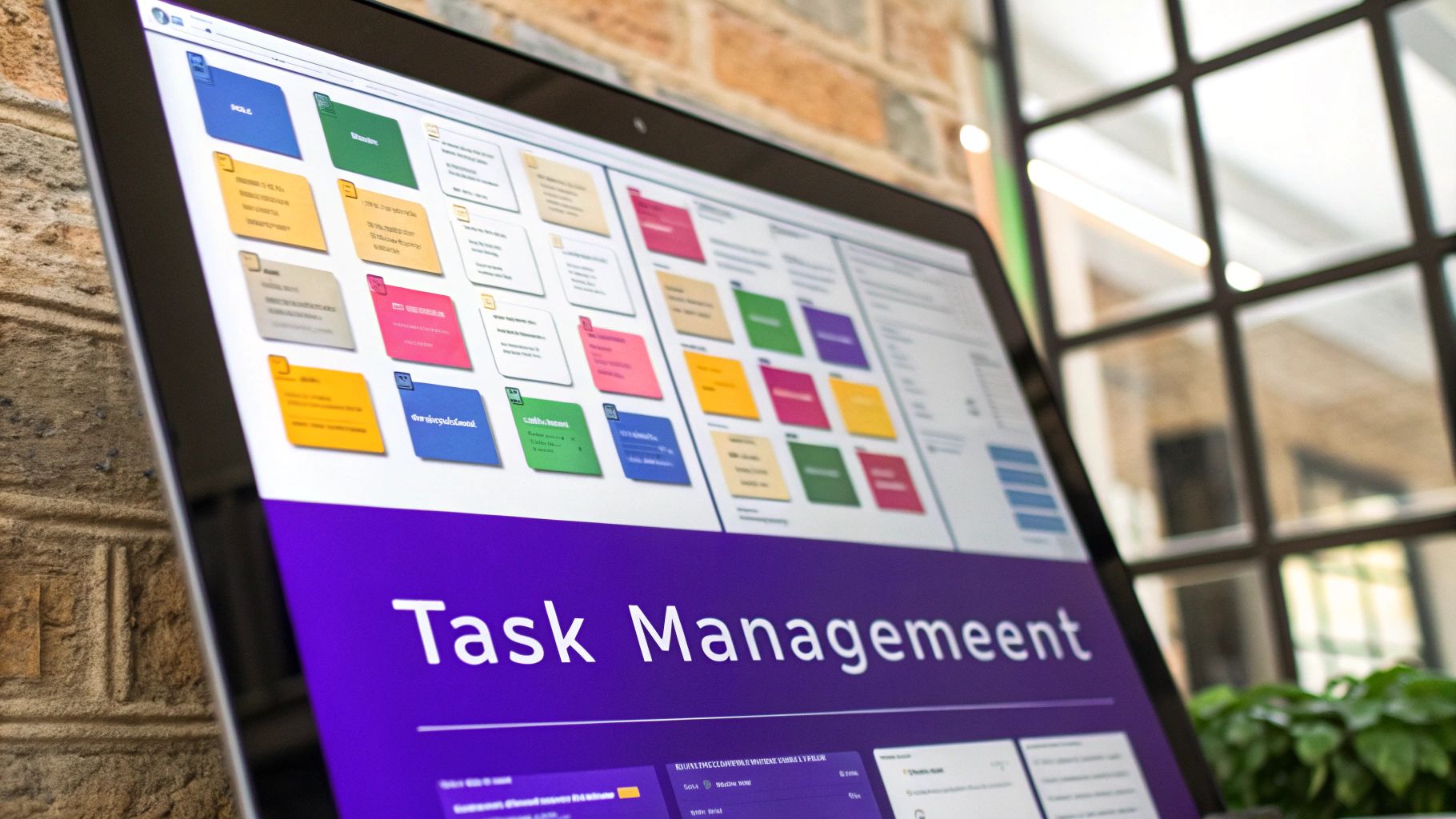The New Rules of Remote Teamwork

Remote work has changed how teams collaborate and get things done. Simply moving office practices online isn't enough anymore. Teams need fresh approaches to work together effectively in a virtual environment, which brings both new challenges and opportunities.
Communication and Collaboration in the Digital Age
Modern teams heavily rely on digital tools to stay connected. Popular platforms like Slack, Microsoft Teams, and Zoom help teams communicate daily. Project tracking tools like Asana and Trello keep everyone accountable and on track. But success requires more than just using these tools – teams need clear communication guidelines and regular check-ins to stay aligned.
Embracing Asynchronous Communication
Remote teams thrive on asynchronous communication, where people don't need to be online at the same time to work together. Team members can share updates and ideas when it works best for them, making it easier to work across time zones. This approach leads to more thoughtful discussions since people have time to consider their responses. Finding the right mix of real-time and async communication is key.
Redefining Productivity in a Remote Setting
Old ways of measuring productivity don't work well remotely. Instead of focusing on hours worked, teams need to look at actual output and results. Remote work lets people schedule their day around when they're most productive. Recent data shows that 12.7% of US workers are fully remote and 28.2% work in hybrid roles. Find more detailed statistics here. This shift means teams must focus on outcomes rather than time spent working.
Building and Maintaining Trust in Virtual Teams
The foundation of successful remote teamwork is trust. Building trust virtually takes extra effort but pays off. Regular virtual social activities help team members connect. Open communication about goals and expectations creates clarity. Leaders should actively share updates and give feedback. When teams follow these principles, they can create strong working relationships even when apart.
Maximizing Remote Team Performance
Remote teamwork takes carefully planned strategies to succeed. Having the right team structure, work environment, and management approach makes a big difference in how well distributed teams perform. Let's explore proven ways to help remote teams excel.
Structuring Remote Teams for Success
Smaller teams often work better in remote settings since they can communicate more easily than larger groups. Think of how a jazz quartet can be more nimble than a full orchestra. This doesn't mean big remote teams can't thrive – they just need well-defined roles and clear communication channels.
Optimizing Work Environments and Management
Individual workspace setup significantly impacts remote work success. Companies should help team members create ergonomic, focused home offices. Management style needs adjustment too – micromanaging hurts remote performance. Focus on outcomes and trust through regular check-ins and transparent expectations.
Let's examine how productivity varies across different groups:
| Age Group | Productivity Level | Key Factors |
|---|---|---|
| Millennials | 66% increased | Tech comfort, work-life balance |
| Gen X | 58% increased | Home office setup, schedule flexibility |
| Baby Boomers | 46% increased | Technology adaptation, workspace design |
Recent data shows 62% of remote workers report higher productivity when working from home. The State of Remote Work Report reveals interesting productivity patterns across demographics.
Overcoming Remote Productivity Blockers
Remote teams face specific challenges like:
- Time zone coordination issues
- Technical difficulties
- Missing in-person social cues
- Limited casual interaction
To address these barriers, successful organizations:
- Create clear communication guidelines
- Use multiple collaboration tools
- Schedule virtual social events
- Provide remote work training
- Foster open feedback culture
Taking a proactive approach to these common remote work challenges helps teams maintain high performance over time.
Breaking Down Virtual Communication Barriers

Good communication makes teams successful, especially when team members work from different locations. For remote teams to do well, companies need to actively work on overcoming the communication challenges that come up when people aren't in the same place. This means understanding what can go wrong and finding ways to communicate clearly through digital tools.
Common Communication Pitfalls in Remote Teams
When teams work remotely, several things can make communication harder. Without face-to-face interaction, it's easy to misread someone's tone or intent in messages. Time zone differences can make it tough to schedule meetings, which slows down decisions. Team members also have different preferences – some like instant messages while others prefer email or video calls. A recent study found that remote work can lead to 8%–19% lower productivity per hour because communication takes more effort. Read more about remote work productivity.
Strategies for Effective Virtual Communication
Strong remote teams use specific methods to overcome these barriers. One key approach is setting clear rules for different types of communication. For example, using Slack for quick questions and project updates, while keeping email for formal announcements. Teams also need to balance immediate communication (like video calls) with delayed communication (like email). While emails and project tools give flexibility, regular video meetings help keep the team connected and allow for deeper discussions.
Optimizing Virtual Meetings
Video meetings are essential for remote teams, but they need proper planning to work well. This includes creating clear agendas, making sure everyone has working technology, and keeping all team members involved throughout the meeting. Tools like Bulby can help make brainstorming sessions more productive and ensure everyone contributes. By tackling communication challenges head-on with these methods, companies can help their remote teams work better together and create a positive virtual work environment.
Creating a Thriving Remote Team Culture
Strong team culture and connections make remote work thrive. Leading organizations know that nurturing trust, belonging, and shared purpose in virtual teams directly impacts engagement, productivity, and employee loyalty.
Building Trust and Community Online
Without natural office interactions, remote teams can struggle to build relationships and camaraderie. Teams often face challenges around isolation and connection. Here are proven approaches for bringing virtual teams together:
- Social Time Together: Regular virtual coffee chats, team games, and casual hangouts help people connect beyond work tasks
- Clear Communication: Being open about goals, challenges and personal updates creates shared understanding
- Engaged Leadership: Leaders need to be present – providing feedback, sharing updates, and joining team discussions to model connection
Many companies organize activities like virtual cooking classes, escape rooms, or book clubs to strengthen team bonds. These shared experiences help create belonging that bridges physical distance.
Creating Purpose and Inclusion
A clear shared mission helps remote teams stay motivated and aligned. Understanding how individual work impacts company goals builds ownership and commitment. Making virtual spaces inclusive and welcoming is also key. This includes:
- Goal Alignment: Regular communication about organizational goals and how each person's work contributes
- Communication Options: Offering multiple channels like chat, video, email so everyone can engage comfortably
- Flexible Work: Accommodating different schedules and circumstances to support work-life balance and inclusion
This focus on mission and flexibility helps attract and keep top talent. It's about building an environment where distributed teams can truly thrive.
Tracking and Improving Team Health
Building great remote culture requires ongoing attention and adjustment. Organizations need practical ways to measure and strengthen virtual team dynamics over time:
- Quick Check-Ins: Brief, regular surveys to gauge team morale, communication, and overall cultural health. Tools like Bulby provide structured ways to discuss culture improvements.
- Open Feedback: Creating safe spaces for team input helps identify areas to strengthen and builds a growth mindset
- Key Metrics: Monitoring engagement, retention, and performance provides insights into cultural initiatives
By focusing on these fundamentals, organizations can build thriving remote cultures that engage employees and drive strong business results in distributed teams.
The Evolution of Remote Collaboration

Remote work has fundamentally changed how teams connect and collaborate. As more organizations embrace distributed teams, there's a growing need to rethink traditional approaches to teamwork and adopt new ways of working together virtually.
Let's look at how remote collaboration has evolved and where it's headed. Here are the key trends and statistics shaping remote work adoption:
| Metric | Current Status | Future Projection |
|---|---|---|
| Remote Work Preference | 98% want some remote work | Expected to increase |
| Average WFH Days | 28% of working days | Stabilizing at 30-40% |
| Virtual Meeting Usage | 70% increase since 2020 | Continued growth |
| Team Collaboration Tools | 80% adoption rate | 95% by 2025 |
The Rise of Remote-First Technologies
Teams now rely on purpose-built tools for virtual collaboration. Bulby and similar platforms offer structured ways to brainstorm and make decisions remotely through features like digital whiteboards and AI-guided facilitation. Virtual and augmented reality tools are also emerging to create more engaging remote experiences that help bridge the physical distance between team members.
Adapting to the Changing Needs of Remote Teams
Remote work is now a core part of how modern teams operate. Research shows that 98% of employees want the option to work remotely at least some of the time, with remote work stabilizing at 28% of total working days. Find more detailed statistics here. This shift requires new approaches to communication, scheduling, and performance management that work for distributed teams.
The Future of Remote Teamwork
As remote work continues to evolve, emerging technologies will play a bigger role in how teams collaborate. AI assistants may help automate routine tasks, while virtual reality platforms could provide new ways for teams to connect and create together. Success in this environment requires staying flexible and open to new tools and practices as remote work capabilities expand. The organizations that thrive will be those that actively embrace these changes while maintaining their focus on effective teamwork and communication.
Essential Tools and Tactics for Remote Success

Making remote work successful takes more than just basic video calls and chat apps. You need the right mix of digital tools working together smoothly, along with clear strategies for using them. The teams that thrive remotely are the ones who thoughtfully select and integrate their tools.
Building Your Virtual Workspace
Just like a physical office needs different spaces for various activities, your digital workspace needs specific tools for different functions:
- Project Management: Asana or Trello help teams track tasks and deadlines in one place
- Communication: Slack or Microsoft Teams enable quick chats, file sharing, and meetings
- Brainstorming: Tools like Bulby make creative sessions more engaging when teams work remotely
- File Storage: Google Drive or Dropbox give everyone access to the latest files
Pick tools that work well together and match your team's specific needs. For example, connecting your task manager to your chat app helps everyone stay updated automatically.
Smart Tool Selection and Setup
Start by identifying your biggest remote work challenges. Are meetings ineffective? Is project tracking messy? Understanding these pain points helps you pick tools that actually solve problems. Consider both your budget and how tech-savvy your team is – even the fanciest tool won't help if people struggle to use it.
Getting tools up and running properly matters just as much as picking them. Create simple guides and hold quick training sessions so everyone knows how to use new tools effectively. Check in regularly to make sure the tools still meet your needs as your team grows and changes.
Learning From Success Stories
Many remote-first companies do an excellent job building their digital workspaces. They focus on tools that make it easy to work at different times, automate routine work, and keep teams connected socially. But they know tools alone aren't enough – they also invest in training, set clear communication guidelines, and build a collaborative culture. Their examples show how to create an effective remote workspace.
Ready to improve your remote team's brainstorming? Try Bulby to unlock your distributed team's creative potential! Learn more about Bulby and start brainstorming.

